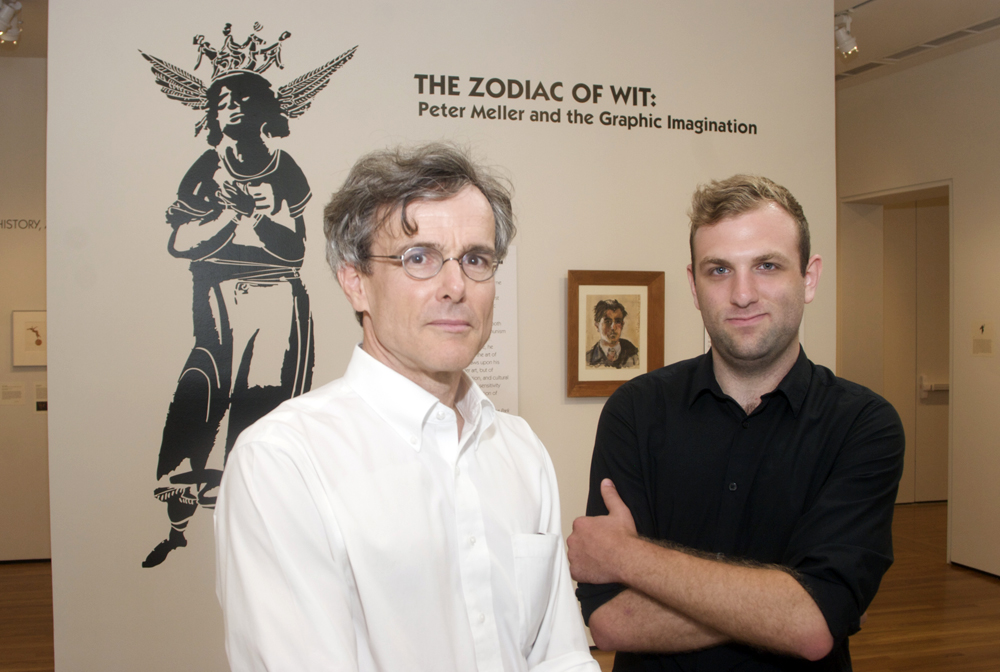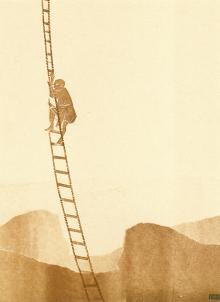
Works by UCSB Art History Professor Emeritus Peter Meller to Show at Jane Deering Gallery in Santa Barbara

Peter Meller, professor emeritus of art history at UC Santa Barbara, was a well-known and well-respected Italian Renaissance scholar, but few of his colleagues –– or even his friends –– were familiar with his work as a graphic artist. A prolific creator of prints and drawings who worked in a variety of media, Meller left as many as 100,000 pieces of work when he died in 2008.
Thirty or so of those pieces are included in an exhibition opening today at the Jane Deering Gallery in Santa Barbara. Titled "The Zodiac of Wit: Peter Meller and the Graphic Imagination," it is part of a larger show of Meller's work currently on display in UCSB's Art, Design & Architecture Museum.
"He used to doodle during staff meetings," recalled Robert Williams, a professor in UCSB's Department of History of Art and Architecture, curator of both exhibitions, and author of a corresponding book about his former colleague. "I knew he was an active artist on the side, but I had no idea to what degree."
When Meller died, Williams was asked to write an obituary, and he visited the home Meller shared with his daughter, Judit, and her husband, John Moore, a UCSB professor emeritus of political science. "They brought out a small box of drawings," Williams recalled. "Then they took me into one room where boxes were stacked floor to ceiling, and then to the garage, and then to a storage shed in the backyard." Williams estimates the boxes contained more than 100,000 pieces of paper and other objects. "Some are duplicates, but even so, they represent an extraordinarily prolific output," he said.
Born in Budapest in 1923 to a Jewish father and a Catholic mother, Meller grew up in privileged circumstances. His father was an architect and acquainted with several leading artists in the city, and his uncle was an art historian who served as director of prints and drawings at Budapest's Museum of Fine Arts.
Meller, who excelled in Greek and Latin, attended the University of Budapest, where he studied classical literature and art history. Despite the rise of the Hungarian Fascist Party in the late 1930's –– as well as the imminence of World War II –– Meller was able to continue his education. That changed in 1944, however, and Meller and his family were forced into hiding. "His immediate family managed to survive, but many members of his father's extended family were lost," Williams noted.
After the war, Meller completed his education and began his career as a professor and as curator at the Budapest Museum of Fine Art. He also got married and started a family. When the Hungarian Revolution began in the mid-1950's, Meller took his wife and daughter and fled the country. "It was a snowy January night in 1957, and Judit remembered hiding in ditches while search parties came through with flashlights," Williams said.
Meller came to UCSB as a visiting professor in 1968, and remained a faculty member in the art history department until his retirement in 1994.
Like many graphic artists, he worked mostly on a small scale, but he developed unusual techniques of his own. Many of his prints were made with a photocopy machine, and he sometimes enhanced the images using common correction fluid. There is an ironic humor also in his use of rubber stamps that he carved himself. "He had a playful attitude toward print technology," explained Williams. "Instead of engravings or etchings, he did Xeroxing. He'd make a drawing, photocopy it, and then if he wanted to rework it, he'd add details and enhancements. He must have chuckled to himself –– here he is with this classical training, and he's using a Xerox machine."
Meller used the same technique with pen and ink drawings, which he photocopied and embellished with a pencil, Magic Marker, correction fluid, or any other medium that allowed him to create the desired effect. "He used Wite-Out to correct, but also as a painting medium," said Williams.
Meller's original designs, which were often modern takes on classical themes, were points of departure for a series of ideas, Williams continued. "That's what makes his working process so amazing and interesting."
The exhibition continues at the Jane Deering Gallery through September 29 and at UCSB through September 16. The Jane Deering Gallery is located at 128 E. Canon Perdido St.
Related Links



